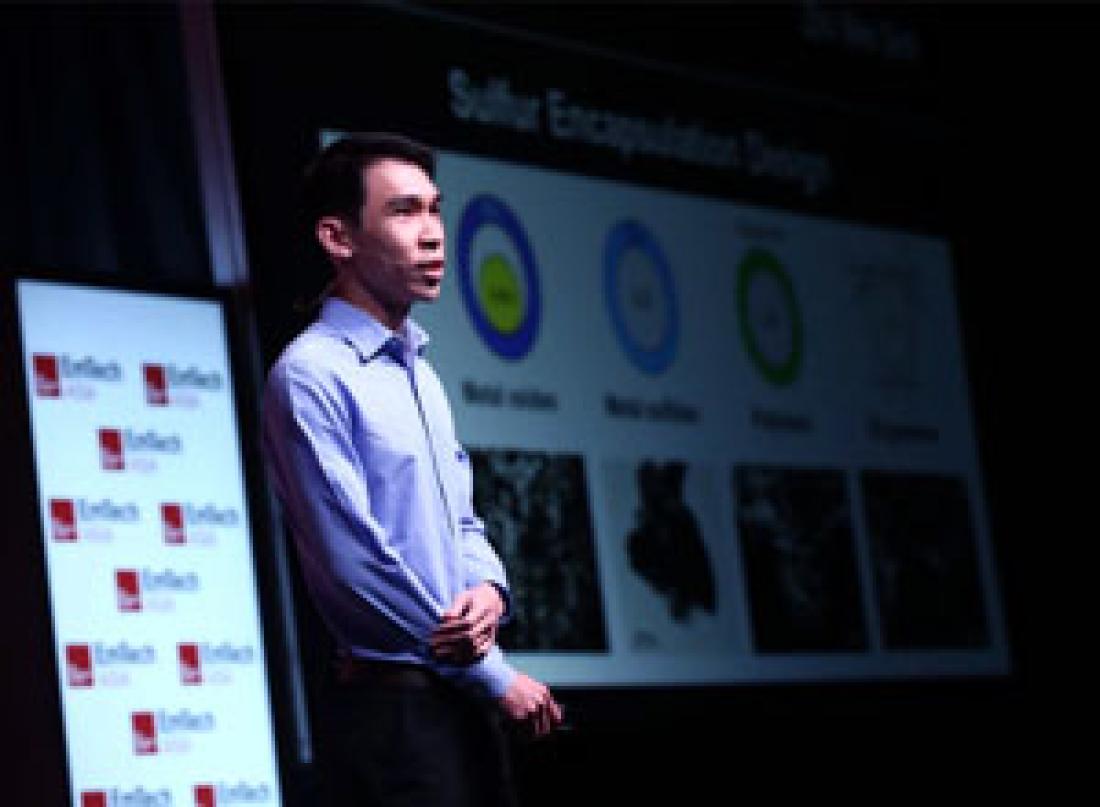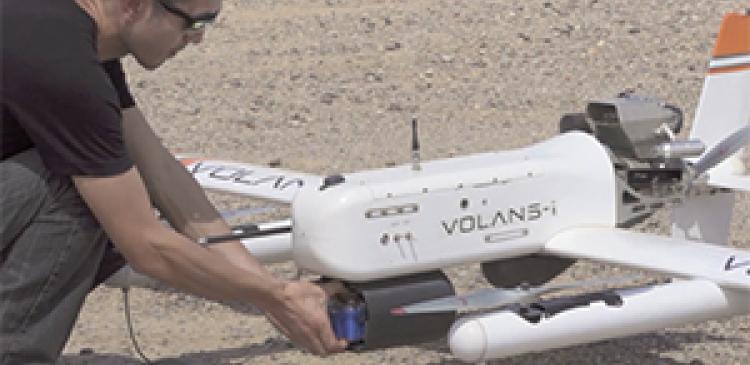In 2017, battery whiz Zhi Wei Seh spoke to a mixed crowd about his research into batteries at the MIT Technology Review's annual EmTech conference.
The desire to super-charge increasingly smart, portable electronic devices using more efficient, large-capacity batteries is palpable. “We hear very sensational reports. For example, that you will soon be able to charge your mobile phone batteries in just a few seconds,” says Guangyuan Wesley Zheng, a chemical engineer at the Institute of Materials Research and Engineering (IMRE) at A*STAR. "While there is a lot of noise and hype, it’s very important research”. Electric cars, he points out “are going to play a significant role in transportation, Boeing and Airbus are talking about aircraft fully powered by electricity and more battery powered electrical appliances are becoming possible, like vacuuming robots.”
Lithium-ion batteries have been the dominant battery on the market since their commercial debut in the early 1990s, used in everything from mobile phones to cars. Tesla, for example, a Silicon Valley-based electric vehicle manufacturer, is now building a ‘Gigafactory’ to dramatically scale up the production of lithium-ion batteries.
However, lithium-ion batteries are reaching the limit of what they can achieve, says Zheng’s colleague, Zhi Wei Seh, a materials scientist at IMRE. “So, instead of making incremental improvements on what lithium-ion batteries can theoretically do, we are exploring drastically different, revolutionary battery technologies.”
From lithium-ion to lithium-sulfur batteries
Many research groups are looking into the potential of lithium-sulfur batteries as an alternative to lithium-ion batteries, but Zheng and Seh are among the most ambitious, both recently named among the MIT Technology Review's top ‘Innovators under 35’ in Asia Pacific.
Lithium-sulfur batteries are attractive because sulfur is cheap and abundant, and the batteries themselves theoretically have energy densities five times larger than lithium-ion batteries. “That means, if we put batteries of the same weight into a car, it could travel five times longer,” Zheng explains. That possibility could also pave the way for applications that lithium-ion batteries cannot handle, such as high-energy stationary grid storage systems for renewable energy sources like solar and wind power.
Like all batteries, lithium-ion and lithium-sulfur batteries store energy in the form of chemical energy, which is converted to electrical energy during discharge. The basic configuration of a lithium-ion battery involves two electrodes made of different materials, both of which are able to store lithium.
When connected to a circuit during discharge, the negative electrode (anode) undergoes oxidation, while the positive electrode (cathode) undergoes reduction. The change in the chemical composition of the electrodes stimulates an electric current to move from the anode to the cathode through the circuitry of the device being powered, and lithium-ions to move from one electrode to another within the battery. When the ions run out the battery becomes flat. When a battery is plugged in to recharge, this process is reversed – the cathode is oxidized, while the anode is reduced – and both electrodes are returned to their original state.
Energy density limits, which along with the lifetime of a battery determine the commercial proposition of a battery, hinge on the expense and ion-carrying limits of electrode materials. A lithium-ion battery’s anode is generally made from graphite, and the cathode from a mix of expensive metal oxides such as cobalt, nickel and manganese. Researchers have been steadily improving battery performance by incrementally adjusting the composition of electrode materials, along with the battery cell design. Nonetheless, because of the basic limits of how lithium ions are stored in these materials, the energy density limit of lithium-ion batteries is still theoretically capped at roughly 420 watt-hours per kilogram (Wh/kg), just enough to power electric cars over distances expected of conventional cars.
But if we want to continue to charge forward lithium-sulfur batteries promise greater performance using a different storage mechanism, explains Seh. The basic function is similar to that of lithium-ion batteries: during discharging, the lithium metal anode is oxidized to form lithium ions that travel through the liquid electrolytes inside the battery to reach the sulfur cathode, where a reaction reduces sulfur to form lithium sulfide. As in lithium-ion batteries, the change in the composition of the electrodes stimulates a flow of electrons from one electrode to another through the circuitry of a device. Again, this process can be reversed during charging.
Unlike conventional lithium-ion batteries, in which ions are inserted into the electrode materials, lithium-sulfur batteries use a metal plating and stripping mechanism on the lithium anode and a conversion reaction, in which the electrode material is transformed from sulfur into lithium sulfide, on the sulfur cathode side1. Negating the need for ions to be inserted into electrode materials means that the theoretical energy density of a sulfur-lithium battery is much, much higher, at 2,500 Wh/kg.
The possibility of lithium-sulfur batteries was discovered as early as the 1960s, but huge technical challenges still obstruct commercialization. On the cathode side, major problems include the low electronic conductivity of sulfur and lithium sulfide, as they are naturally insulating. Also, faster lifetime decay occurs during a battery’s energy cycling because of the build-up of lithium deposits, and because intermediate materials known as lithium polysulfides, which are important to maintain the cathode’s performance, dissolve quickly into the battery's electrolytes, leading to a continuous loss of important active materials.
Researchers have been trying to solve the first problem by coating sulfur particles in a conductive material. A breakthrough came in 2009 when a Canadian team developed a technology to encapsulate sulfur particles within a highly-ordered framework made of porous carbon, which is conductive2. However, as a sulfur particle’s volume expands by as much as 80 per cent upon reacting with lithium, it often cracked the protective coating, inducing the problematic polysulfide dissolution. Stable performance could thus be achieved only over 20 charge-discharge cycles (for comparison, the lifetime of a conventional lithium-ion AAA battery has roughly 500–1,000 cycles). Nonetheless, since 2009, research into lithium-sulfur batteries has been accelerating.
Inspiration from an egg
Both Seh and Zheng made significant advancements in the science several years ago when they were PhD students at the lab of Professor Yi Cui at Stanford University. It was Seh who looked into the volume expansion problem. “I came up with an idea similar to an egg structure,” Seh says. “Imagine the sulfur is an egg yolk and the white is empty space.”
The team developed a technology to coat sulfur nanoparticles with titanium oxide, and then allow some dissolution of the sulfur to create a void inside the shell to accommodate the volume expansion of sulfur3. As a result, the capacity decay after 1,000 cycles was as small as 0.033 per cent per cycle, which represented the best performance of a lithium-sulfur battery at the time.
Inspired by this yolk-shell structure, the performance of lithium-sulfur batteries reported in literature improved greatly, Seh says, and now some groups have even demonstrated 10,000 cycles.
Zheng, on the other hand, led a project to investigate one of the other issues that makes commercialization difficult, the lithium anode. The anode tends to form dendritic and mossy metal deposits within the battery, one of the major causes of the battery’s short lifetime.
His team initially considered using a carbon thin film to coat the lithium anode, but the coating cracked after a few cycles. After several attempts, they resolved the issue using a hollow carbon nanosphere approach.
Unlike conventional approaches focused on modifying anode materials to prevent dendrite formation, their approach focused on accommodating shape changes of the anode. As the hollow carbon nanosphere coating is highly flexible and robust, it can withstand the large volumetric changes of the lithium anode during energy cycling, thus allowing the battery to continue functioning4.
“The result provided a new perspective on how simple nanotechnology can help address long-standing problems in lithium batteries,” Zheng says. His team has since made more iterations, including using a self-healing polymer and other coating methods, and he says these results also show good cycling at higher current densities.
Road to commercialization
Since moving back to Singapore from Stanford in the USA and joining A*STAR in 2016, the two scientists have been exploring new angles of the lithium-sulfur battery question. Zheng is pushing hard for the commercialization of lithium-sulfur batteries. Looking at the potential of advanced battery technology, he runs a San Francisco-based company called Volans-i in collaboration with a friend, Hannan Parvizian, to build drones, and operate a delivery service across long distances. They still use traditional lithium-ion batteries because lithium-sulfur battery packs are still being developed, but they ultimately need a battery platform robust enough to “deploy drones around the world,” Zheng says.
Their progress is impressive. Volans-i has received funding from prominent investors such as Y-Combinator, and hybrid battery and gasoline models have achieved a long-range cruise drone of up to 1,600 kilometers at a maximum speed of 322 kilometers per hour. UNICEF has also recently approached the company and invited it to bid in its drone project to distribute vaccines to people on the small Pacific island of Vanuatu.
Meanwhile, as many start-up companies and automakers are competing to develop prototypes of lithium-sulfur batteries, Zheng last year set up a company called Coulomb Innovation in Singapore with a friend to commercialize the lithium-sulfur technology, with a focus on material production. Zheng is now preparing to scale up the production of sulfur nanoparticles as a first step to practical application. In addition, his team is making pouch cell (a type used in newer laptops, mobile phones and electric cars) prototypes of lithium-sulfur batteries in a laboratory at IMRE, while trying to produce a battery pack that can power some devices such as drones and small robots.
Seh's team is investigating batteries that use alternatives to lithium, such as magnesium and aluminum, which are not only plentiful and much cheaper, but have two to four times greater charge capacity. Using these materials could also help avoid the issue of dendritic deposits, which are caused by the reactivity of lithium metal, eating away at the effectiveness and lifetime of the batteries. However, magnesium and aluminum ions are larger and often reported in literature to be slow and sluggish, says Seh. His team is searching for the best way to manipulate these materials "to move ions very fast during charging and discharging.”
Both scientists believe next-generation rechargeable sulfur-lithium batteries are very close to commercialization. “With our accumulated knowledge over the past few years, we are now seeking companies to work together, and we will have more prototype cells by the end of the year,” Zheng says. “As for magnesium and aluminum batteries, we still don’t fully understand these emerging battery technologies, including what is the most suitable electrode and electrolyte materials,” Seh adds. “But we hope to start making coin cells over the next 5–10 years and then build bigger cells that can really impact our lives.”
A*STAR-affiliated researchers contributing to this research are from the Institute of Materials Research and Engineering (IMRE).
Zheng's faith in the quick evolution of batteries is evident in his start-up company, Volans-i, which relies on advanced battery technology to help its drones do deliveries across very long distances. Seeded at the same start-up accelerator that founded AirB&B, Volans-i is bidding to work on vaccine delivery on Vanuatu for UNICEF.




